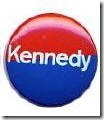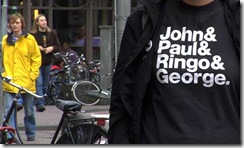1. Attitude
 I'll never forget being the only white guy in a rundown picture theatre in Astoria the summer of 1989 when the afrocentric Do the Right Thing came out. The papers - well, the Voice - were talking about nothing else (black critic Stanley Crouch panned it). There's an excellent profile of Spike Lee in the September 22 New Yorker which captures his still burning attitude, and how that has hindered his career. It closes with the writer John Colapinto asking Lee why he hasn't directed a TV ad for the Obama campaign: after all, the Obamas went to Do the Right Thing on their first date:
I'll never forget being the only white guy in a rundown picture theatre in Astoria the summer of 1989 when the afrocentric Do the Right Thing came out. The papers - well, the Voice - were talking about nothing else (black critic Stanley Crouch panned it). There's an excellent profile of Spike Lee in the September 22 New Yorker which captures his still burning attitude, and how that has hindered his career. It closes with the writer John Colapinto asking Lee why he hasn't directed a TV ad for the Obama campaign: after all, the Obamas went to Do the Right Thing on their first date:
“You gotta be asked to do that stuff,” Lee said. “Look, if they need me, they know where I am. And in a lot of ways they might—” He paused. “You know, that shit could be used against them, too. ‘Spike Lee, the man who said so-and-so and so-and-so. Now he’s doing commercials for—’ ” He shrugged and smiled. “Sometimes you might be a liability,” he said finally. “Just got to lay in the cut.”
Elsewhere, he says that having a black president would change everything, people's psyche, and specifically African-Americans: “They don’t have to be shuckin’ and jivin’—doing the tap dance—to make a living. And I mean that ‘tap dancing’ figuratively, not literally, because no disrespect to the world’s greatest tap dancer, Savion Glover.”
I don't know Savion Glover, but the quote reminded me of a great black variety performer who grew up in the dying days of minstrelsy and ended up being patronised by Sinatra and the rest of the Rat Pack. A while back I came across this clip, in which Sammy Davis Jr paid tribute to a host of other performers, with Harold Arlen's timeless 'One for My Baby'. I must read Davis's autobiography ... that's odd, it was called Yes I Can. He achieved a lot in an era when he couldn't stay in the same Las Vegas hotels in which he was performing. What would he have done in this era?
2. Mrs Brown's Daughter
The jury is still out on Tina Brown's new site The Daily Beast. Smartly designed, exuding that mix of brains and glitz, you can see why the investors went for it. But so far it feels a little corporate. The Huffington Post probably has similar backing and Rolodex of contacts, but has a guerilla madness about it that gives it an edge. The Huff's shrillness is off-putting, so maybe it's just a left alternative to Fox News; as a Hoboken friend pointed out to me in the 80s, yes the Village Voice has some good stuff in it, but so often it just seems like a smart, far-left answer to the (sensationalist, right-wing) New York Post. But this piece from The Daily Beast is an excellent use of the web: "How McCain Can Still Win". The design is so simple but clever: just by rolling your mouse over the image, you can read a precise of what several well-informed pundits think of McCain's chances. Despite what the polls say in the battleground states, hearing what the more rabid Republicans are saying - the ugly face of a more widespread, hidden racism - I'm not putting my share portfolio on an Obama victory. Oh that's right, I don't have one.
3. Type Cast

 My first awareness of Helvetica was early in 1968 when a quasi-relative in the US sent out some buttons from RFK's doomed campaign. At the time the font seemed so fresh, so bold, so obviously from somewhere else than New Zealand in the era of Holyoake and one-channel TV. If you haven't seen it, the documentary Helvetica is fascinating. Here's a montage.
My first awareness of Helvetica was early in 1968 when a quasi-relative in the US sent out some buttons from RFK's doomed campaign. At the time the font seemed so fresh, so bold, so obviously from somewhere else than New Zealand in the era of Holyoake and one-channel TV. If you haven't seen it, the documentary Helvetica is fascinating. Here's a montage.
There are other viruses that we could eliminate first, but the use of Arial is certainly somewhere on the list. It's the rich man's Helvetica - Bill Gates is responsible - but the poor man's sans serif. Minnesota graphic artist and type designer Mark Simonson has an elegant site sharing his knowledge - and love - of classic type faces, and he has a great piece called "The Scourge of Arial":
Arial is everywhere. If you don’t know what it is, you don’t use a modern personal computer. Arial is a font that is familiar to anyone who uses Microsoft products, whether on a PC or a Mac. It has spread like a virus through the typographic landscape and illustrates the pervasiveness of Microsoft’s influence in the world. Arial’s ubiquity is not due to its beauty. It’s actually rather homely. Not that homeliness is necessarily a bad thing for a typeface. With typefaces, character and history are just as important. Arial, however, has a rather dubious history and not much character. In fact, Arial is little more than a shameless impostor.
Also worth checking out is his obsessive take on the errors film designers make when being lazy about the retro type faces they use. And recently he has cast his eye over the type in Mad Men: it must be very distracting looking at everything through a typographer's eye, sometimes you couldn't see the woodblock for the trees.




No comments:
Post a Comment